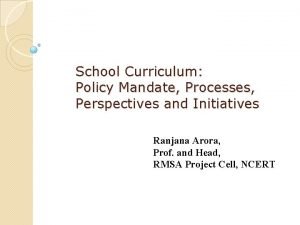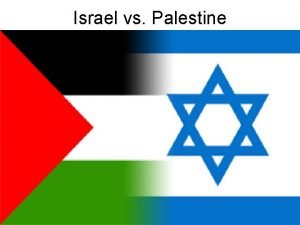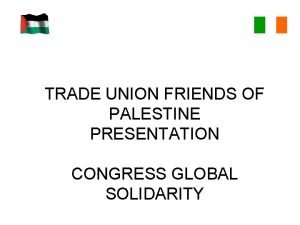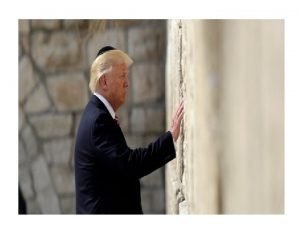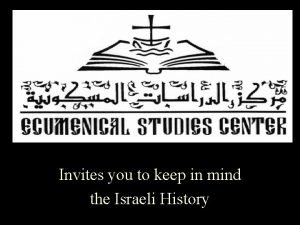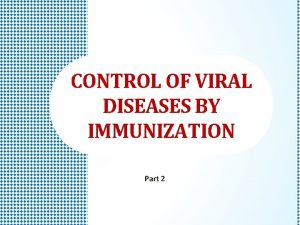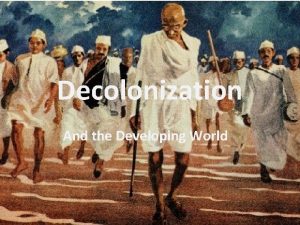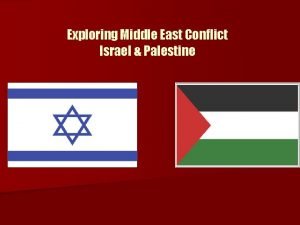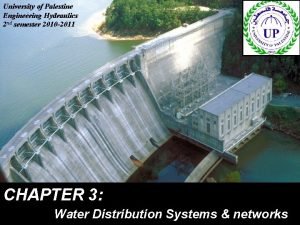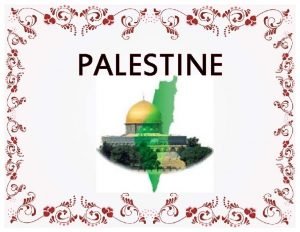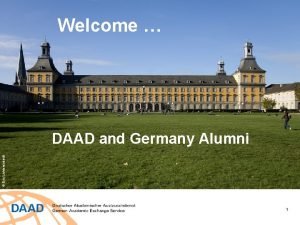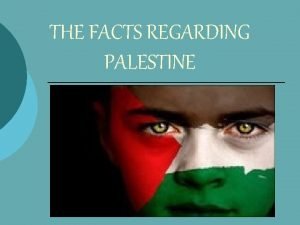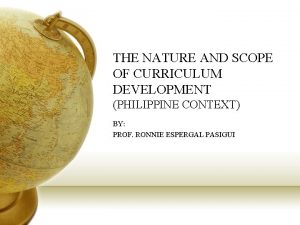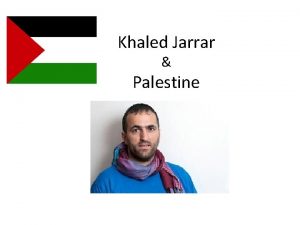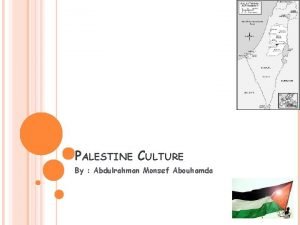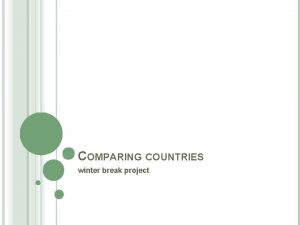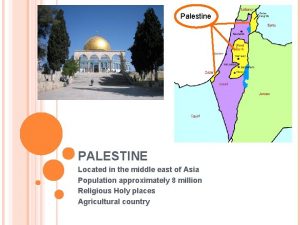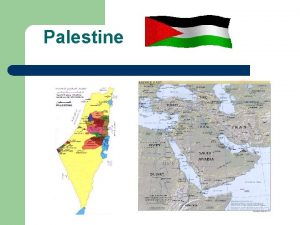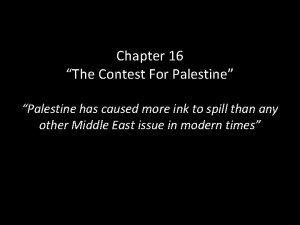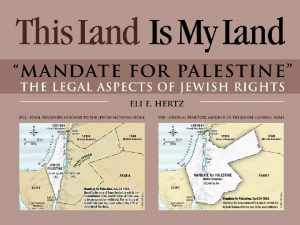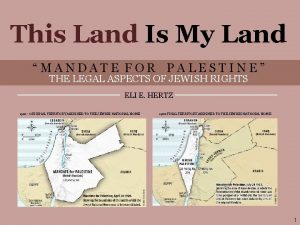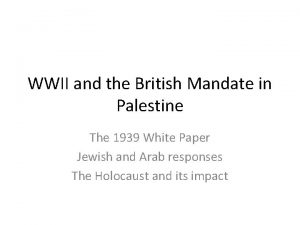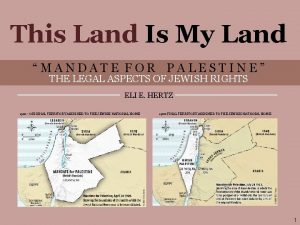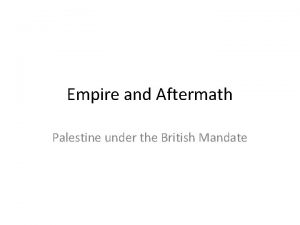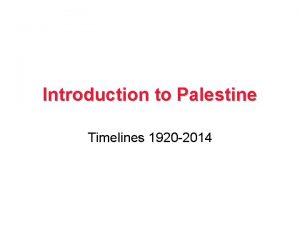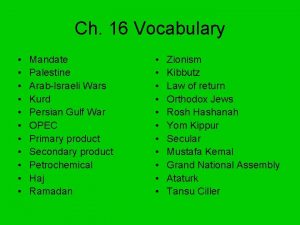Palestine during the Mandate n The Mandate Period


















- Slides: 18

Palestine during the Mandate n The Mandate Period witnessed the complete reconfiguration of Palestine. n The agenda for this process was set out in the Balfour Declaration in which Britain undertook to support the creation of a Jewish Homeland in Palestine. n “Nothing was more important to the development of the Jewish Yishuv in Palestine than immigration, and nothing was more central to the Arab’s fear of Zionism. ”

Aliyahs and Yishuv n Jewish immigration to Palestine, referred to as Aliyah, occurred in six waves from 1882 to 1948. n At the time of the first Aliyah the Yishuv, Jews living in Palestine, numbered 24 000. n The first Aliyah, from 1882 – 1903 involved about 25 000 Jews. n The second Aliyah, from 1904 – 1914, increased the Jewish population to 90 000. n During the war the Jewish population of Palestine had decreased to approximately 55 000.

Palestine Bethlehem 1875 n n Jerusalem 1890 n n The fellahin constituted the majority of Palestinians population. In 1921 approximately 80% of the indigenous population of Palestine depended on agriculture. Towns and villages dotted the Palestinian landscape, but these generally had small populations. They were perhaps the primary socio-political and cultural centres of rural life.

Immigration n n At the Paris Peace Conference, Chaim Weizmann petitioned the leaders of the victorious powers to allow 70 – 80 000 Jews a year to immigrate to Palestine. Winston Churchill, the Colonial Secretary supported the call. Arabs Jewish % of total 1918 700 000 60 000 < 10% 1928 817 000 156 000 ± 16% 1938 1 070 000 412 000 ± 29% 1945 1 250 000 555 000 ± 30, 6%

Working Class & Zionism n n n Between 1921 and 1936 Jewish workers increased from about 5 000 to 29 000. Private entities invested $400 million to support the development of Jews. The birth of a working class created the conditions for class solidarity between Arab and Jewish workers. But the Histadrut campaigned for : Jewish companies only to employ Jewish workers. Jewish only membership of trade unions David Ben-Gurion

Shaw and Hope Simpson Commission Concluded: n Attacks on Jews were unpremeditated. n The fundamental cause of the conflict was Arab landlessness and fears about Jewish immigration. n It condemned the exclusionary labour practices of the Zionists. Recommended: n A reduction in Jewish immigration to Palestine. n Tighter control of land purchases.

Land Acquisition n Zionist land acquisition presented a sustained threat to the fellahin. n In 1933, 673 acquisitions took place and in 1934, 1178. n This process rendered about 30 000 Palestinian fellahin landless. n Land ownership gave territorial expression to Zionists’ political objectives. n Palestinians perceived the Zionist project as an expropriation of their land, on which they had lived and worked for many centuries.

Great Arab Revolt n Political tension rose because of the sharp increase in Jewish immigration. n In 1930, 4 000 Jews officially arrived in Palestine. In 1935 that increased to 62 000. n In April 1936 the Higher Arab Committee, led by Amin Al-Husayni, called a General Strike to protest against Jewish immigration. n The urban rebellion came under severe attack from July 1936 and was smashed by British forces

Rural Rebellion n Rural rebellion reached a climax in 1938. n The rebels numbered more than 15 000 and established a quasi-autonomous government. n British responded first by mobilising 20 000 troops, the Royal Air Force. n About 15 000 Zionists were trained and placed under arms. n Five thousand Palestinians were killed and 14 000 injured. n 101 British and 463 Jews died.

Peel Commission n Found that: n Palestinians had a strong desire for national independence. There was widespread fear about the establishment of a Jewish Homeland. It concluded that there were irreconcilable differences between Jews and Arabs. n n n The Peel Commission recommended the creation of a small Jewish state that would include most of the fertile lands of Palestine.

n Partition Plan, 1937

World War 2 n The horrors of the holocaust in which 6 million European Jews were massacred swung Western opinion decisively in favour of the Zionist cause. n The war signalled the emergence of the US as the primary global capitalist power. n In 1945 an Anglo-American Committee endorsed the Zionist demand immediately to issue 100 000 immigrant certificates.

Militarisation of Zionism n In July 1938, Jabotinsky’s Revisionist embarked on a bombing campaign of public spaced in Haifa, Jaffa and Jerusalem, killing at least 100 Arabs. n Zionist militias, Irgun and Stern, stepped up their guerrilla war against the British. n The King David Hotel bombing resulted in the deaths of 91 people. n By the end of 1946 373 people had been killed in these attacks.

Declaration of Israel or Nakba? n Zionists acted swiftly to pre-empt any stalling of the implementation of the UN plan. n Attack on Deir Yassin resulted in 254 deaths. n Attacks on Palestinian villages caused the displacement of between 700 000 and 900 000 Arabs. n Israel declares independence on 14 May 1948

Refugee crisis n Zionists have argued that Palestinians were instructed to flee villages. n Research by Benny Morris, Avi Shlaim, Ilan Pappe concluded that most Palestinians fled because their villages were attacked or out of fear. n Shlaim argues that the Hashemite rulers of Transjordan signed agreement with the Zionists to divide a conquered Palestine between them.

Attack by Arab armies Conventional view has been that Arab armies posed a real threat to Israel, which view persists. Arab countries attempt military response but can only mobilise about 21 000 poorly trained troops (Egypt – 10 000; Transjordan – 4 500; Syria – 3 000; Iraq – 3 000 and Lebanon – 1 000). n By contrast Israel has over 60 000 well-trained soldiers and easily defeat the joint Arab forces.

Post 1949 n By January 1949 only 21% of Palestine remained in the hands of the indigenous Arab population. n Israeli Knesset promulgates the Law of Return and the Absentee Property Law. Under these laws any Jewish person, anywhere in the world is entitled to become a citizen of Israel. n Palestinian Arabs were denied citizenship. n By 1972 there were 1, 5 million registered refugees.

n David Ben Gurion: “If I were an Arab leader I would never make terms with Israel. That is natural: we have taken their country … We come from Israel, but two thousand years ago, and what is that to them? There has been anti. Semitism, the Nazis, Hitler, Auschwitz, but was that their fault? They only see one thing: we have come here and stolen their land. Why should they accept that? ”
 Recommendations of ncf 2005
Recommendations of ncf 2005 Israel palestine war
Israel palestine war English for palestine grade 6
English for palestine grade 6 Palestine
Palestine How many countries recognize palestine
How many countries recognize palestine Golda meir quotes
Golda meir quotes Vaccination schedule in palestine
Vaccination schedule in palestine इजराइल एंड पलेस्टाइन
इजराइल एंड पलेस्टाइन Palestine 1967 borders
Palestine 1967 borders Palestine red profile picture
Palestine red profile picture Palestine hydraulics
Palestine hydraulics Israel palestine map over time
Israel palestine map over time Palestine flag
Palestine flag Daad alumni portal
Daad alumni portal Who is this woman
Who is this woman Palestine
Palestine Physical education in renaissance period
Physical education in renaissance period Japanese devised curriculum in the philippines
Japanese devised curriculum in the philippines Whats laissez faire
Whats laissez faire
